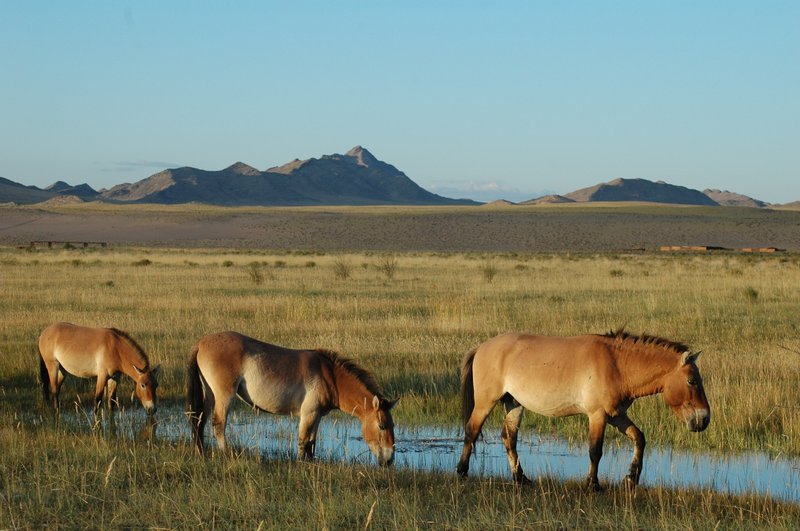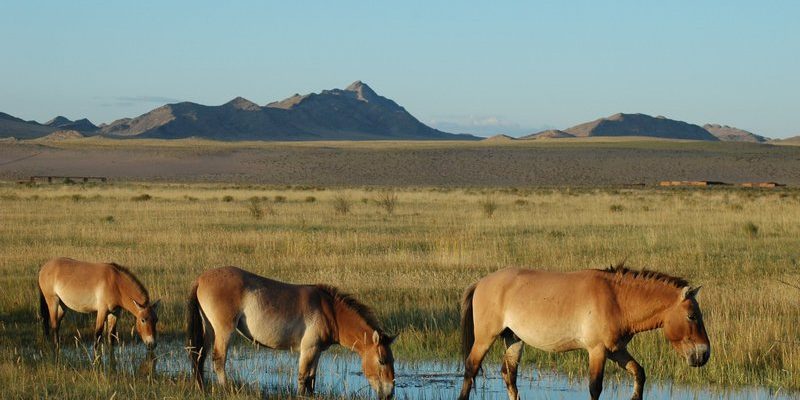
You could think of the Przewalski’s horse as the original horse, existing in the grasslands of Central Asia long before humans started riding horses. Just like how you might cherish a family heirloom, these horses represent a direct connection to our planet’s past, and their presence in their natural habitat plays a crucial role in maintaining that ecosystem. Let’s delve deeper into how they fit into the web of life in their grassland homes.
What Makes Przewalski’s Horse Unique?
First off, Przewalski’s horses are a bit different from what you might expect. They have a stocky build, a short, upright mane, and a unique dun coat with a lighter underbelly. Standing at around 12 to 14 hands high (about 4 to 5 feet tall at the shoulder), they are smaller than many domestic horses. This unique appearance is more than just for show; it’s tied to their survival in the wild.
These horses are also renowned for their resilience. They’ve adapted to harsh environments, like the steppes of Mongolia. They can survive with minimal water, getting most of their moisture from the grasses they graze on. Plus, their herding instincts help them stay safe from predators like wolves and leopards. This instinctual behavior not only helps them thrive but also supports the larger animal community.
The Role of Przewalski’s Horse in Grazing Dynamics
Grazing animals like the Przewalski’s horse play a significant role in maintaining the balance of their ecosystem. By feeding on grasses, they help control plant growth. Imagine overgrown grasslands; they could become less healthy, encouraging a decline in biodiversity. The horses’ grazing habits ensure a diverse range of plant life.
This uniform grazing can prevent the dominance of a few plant species, allowing a variety of plants to flourish. Their eating habits create open patches in the landscape. These patches can be crucial for other organisms, like insects and smaller mammals, which rely on varied habitats.
Moreover, the horses’ droppings contribute to nutrient cycling. Their waste fertilizes the soil, promoting healthy plant growth. This leads to a richer ecosystem where diverse species can thrive. So, every time you see Przewalski’s horses munching away, they’re essentially gardening their habitat, keeping it vibrant and full of life.
Predator-Prey Dynamics in Their Habitat
The presence of Przewalski’s horses also impacts predator populations. When horses roam and graze, they attract predators, which can lead to a healthy predator-prey balance. Think of it like a dinner party; if you invite only a few guests, the evening may feel empty. But when you fill the room, everyone’s interactions become richer and livelier.
These horses can also help control herbivore populations. By being prey to natural predators, they contribute to a balanced food web. If their numbers rise unchecked, you might see a decline in grassland health, as overgrazing could occur. The circle of life, right? It’s a delicate dance between the horses and their predators, keeping the ecosystem in harmony.
The Importance of Genetic Diversity
One of the most compelling reasons to protect Przewalski’s horses is their genetic diversity. With a history of near extinction due to hunting and habitat loss, conservation efforts have brought them back from the brink. But here’s the catch: even with protective measures in place, their population remains quite small.
Genetic diversity is crucial for any species’ survival. A diverse gene pool helps populations adapt to changing environments and resist diseases. Imagine if everyone in a community had the same skill set—if a disaster struck, there wouldn’t be enough varied talents to solve problems. The same goes for animal populations.
Conservationists are working hard to reintroduce Przewalski’s horses into their natural habitats and boost their numbers. This effort isn’t just about saving one species; it’s about preserving the intricate web of life that relies on their existence.
The Role of Przewalski’s Horse in Cultural Identity
The Przewalski’s horse holds a special place in the cultural and historical identity of Mongolia. For many local communities, these horses symbolize resilience and freedom. They’ve inspired folklore, art, and stories that reflect the deep connection between the land and its inhabitants.
By protecting these horses, communities also protect their cultural identity. Conservation efforts often have the backing of local people who see value in maintaining their heritage. It’s a win-win situation—keeping the Przewalski’s horse alive helps preserve nature and the stories that define a community.
Moreover, ecotourism centered around these horses can benefit local economies. Tourists drawn to watch these majestic animals in their natural habitat contribute to the financial well-being of surrounding communities. It’s like creating a symbiotic relationship, where both nature and people thrive together.
Conservation Efforts for Przewalski’s Horse
Thanks to ongoing conservation efforts, the Przewalski’s horse is slowly making a comeback. Organizations worldwide are dedicated to breeding programs, habitat restoration, and educational initiatives. These efforts are crucial, as they help raise awareness about the importance of preserving not only the horses but also their natural environment.
Breeding programs, especially in zoos, have led to successful reintroductions into the wild. However, challenges remain. Habitat loss and climate change are ongoing threats to their survival. This is where community engagement comes into play. If locals understand the importance of these horses, they’re more likely to support conservation initiatives.
So, how can you help? Supporting organizations focused on wildlife conservation, spreading awareness, or even visiting protected areas to learn about these horses can make a difference. Every action counts, no matter how small.
In conclusion, the Przewalski’s horse is more than just a unique species; they are a vital piece of the ecosystem puzzle. From maintaining grazing dynamics to being a key player in predator-prey relationships, these horses support the health of their habitat. Plus, their cultural significance and role in biodiversity makes them indispensable to both nature and people.
Understanding and appreciating their importance is crucial for future generations. By protecting Przewalski’s horses, we are also safeguarding a part of our natural heritage. So, the next time you hear about these incredible creatures, remember that their survival impacts us all, weaving a thread through the tapestry of life on Earth. Together, we can ensure that this living link to our past continues to run wild for years to come.

